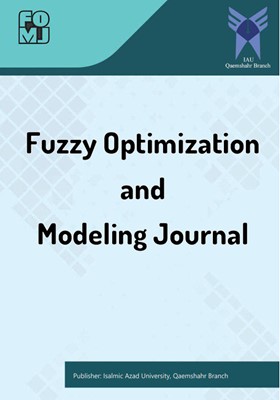Enhancing Recruitment Efficiency: Leveraging Fuzzy Logic Optimization for Effective Skill Management in Human Resources
Subject Areas : Fuzzy Optimization and Modeling JournalFarideh Majidi 1 * , Maryam Khademi 2
1 - Department of computer engineering, Islamic Azad University (south branch), Tehran, Tehran
2 - Department of computer engineering, Islamic Azad University (south branch), Tehran, Tehran
Keywords: fuzzy logic, Optimization, Fuzzy linear programming, Human Resources, simplex method,
Abstract :
The application of fuzzy linear programming and optimization techniques has a rich history in various domains. In recent years, the rise in employee terminations within large companies has underscored the significance of employee performance and its impact on organizational progress. To address this issue, it becomes crucial to determine the appropriate number of employees required to effectively execute company projects, considering employee performance and organizational needs. Additionally, it is essential to identify an optimal employee count as a benchmark prior to hiring. This optimal value can be achieved through the utilization of optimization methodologies, such as fuzzy linear programming. This research paper presents a solution to the employee hiring problem in a factory by utilizing the fuzzy linear programming method. The findings reveal that increasing the number of hires does not necessarily correlate with enhanced performance. The findings of this paper enable organizations to make informed decisions regarding employee recruitment and enhance overall operational efficiency.
1. Abu, M. S., Aik, L. E., Choon, T. W., & Arbin, N. (2022). Simplex method for profit maximization in bakery store. International Journal of Advanced Research in Technology and Innovation, 4(2), 92-98.
2. Adedipupo, O. O., Abideen, L. T., Samson, O. T., Ayodeji, F., & Oladipupo, O. K. (2022). Application of linear programming for decision making to business in Whao Beverages Nig. Ltd. American Journal of Applied Mathematics, 10(3), 86-92.
3. Aviso, K. B., Mayol, A. P., Promentilla, M. A. B., Santos, J. R., Tan, R. R., Ubando, A. T., & Yu, K. D. S. (2018). Allocating human resources in organizations operating under crisis conditions: A fuzzy input-output optimization modeling framework. Resources, Conservation and Recycling, 128, 250-258.
4. Almseidin, M., Al-Sawwa, J., & Alkasassbeh, M. (2021, July). Anomaly-based intrusion detection system using fuzzy logic. In 2021 International Conference on Information Technology (ICIT) (pp. 290-295). IEEE.
5. Cormen, T. H., Leiserson, C. E., Rivest, R. L., & Stein, C. (2022). Introduction to algorithms. MIT press.
6. Das, S., & Chakraborty, D. (2022). Graphical method to solve fuzzy linear programming. Sādhanā, 47(4), 259.
7. da Silva, R. F., de Araújo Costa, I. P., dos Santos, M., Fávero, L. P. L., Santos, L. J. T., Moreira, M. Â. L., & Kojima, E. H. (2022). Tariff Optimization under incentive regulation of public services using simplex method. Procedia Computer Science, 214, 1325-1333.
8. Dhunny, A. Z., Doorga, J. R. S., Allam, Z., Lollchund, M. R., & Boojhawon, R. (2019). Identification of optimal wind, solar and hybrid wind-solar farming sites using fuzzy logic modelling. Energy, 188, 116056.
9. Hartanti, D., Aziza, R. N., & Siswipraptini, P. C. (2019). Optimization of smart traffic lights to prevent traffic congestion using fuzzy logic. Telecommunication Computing Electronics and Control, 17(1), 320-327.
10. Mahdavi-Amiri, Nezam & Nasseri, Hadi & Yazdani, Allahbakhsh. (2009). Fuzzy primal simplex algorithms for solving fuzzy linear programming problems. Iranian Journal of Operations Research. 1. 68-84.
11. Rommelfanger, H. (1996). Fuzzy linear programming and applications. European journal of operational research, 92(3), 512-527.
12. Saghi, S., Nazemi, A., Effati, S., & Ranjbar, M. (2023). Simplex algorithm for hesitant fuzzy linear programming problem with hesitant cost coefficient. Iranian Journal of Fuzzy Systems, 20(1).
13. Tripathi, D. K., Nigam, S. K., Rani, P., & Shah, A. R. (2023). New intuitionistic fuzzy parametric divergence measures and score function-based CoCoSo method for decision-making problems. Decision Making: Applications in Management and Engineering, 6(1), 535-563.
14. Vasant, P., Nagarajan, R., & Yaacob, S. (2004). Decision making in industrial production planning using fuzzy linear programming. IMA Journal of Management Mathematics, 15(1), 53-65.
15. Veeramani, C., & Duraisamy, C. (2012). Solving fuzzy linear programming problem using symmetric fuzzy number approximation. International journal of operational research, 15(3), 321-336.
16. Wang, Y., Zhang, Y., Zhang, C., Zhou, J., Hu, D., Yi, F., & Zeng, T. (2023). Genetic algorithm-based fuzzy optimization of energy management strategy for fuel cell vehicles considering driving cycles recognition. Energy, 263, 126112.
17. Yuan, R., Wu, Z., & Tu, J. (2023). Large-scale group decision-making with incomplete fuzzy preference relations: The perspective of ordinal consistency. Fuzzy Sets and Systems, 454, 100-124.
18. Zimmermann, H. J. (2011). Fuzzy set theory and its applications. Springer Science & Business Media.

